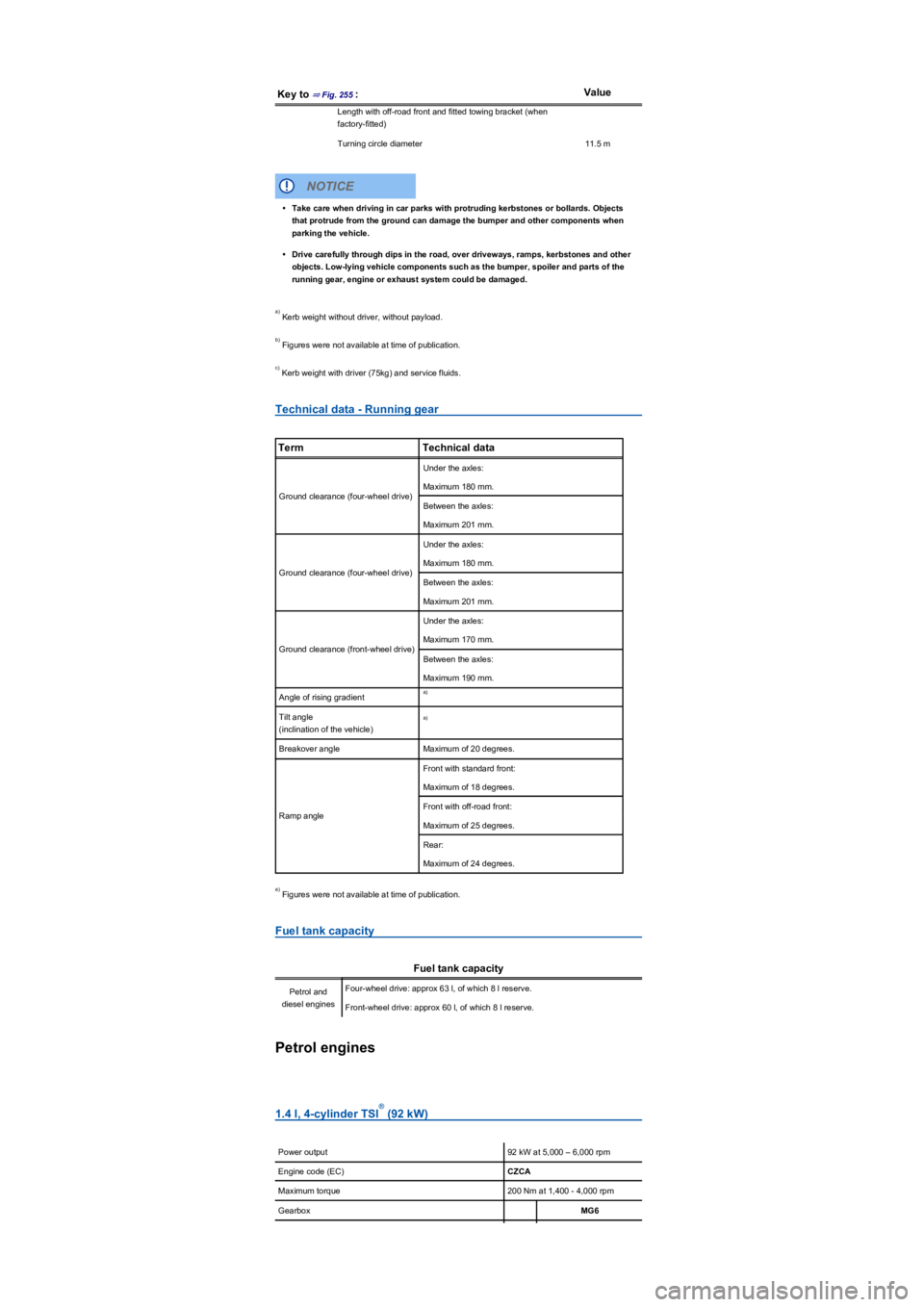Page 304 of 341

Maximum load and speed range for tyres
First read and observe the introductoryinformation and safety warnings⇒
Introduction
Vehicles in the EU and the so-called EU user states are issued an EC Certificate of Conformity.
This details the size, diameter and speed range of all tyres approved by Volkswagen for the
relevant vehicle type.
The type plate shows whether there is an EC certificate of conformity for this particular vehicle. The
type plate can be seen on the lower part of the door pillar when the door is open ⇒ Technical data.
•If the type plate has a row marked Permit then the vehicle does have an EC certificate of
conformity.
•If there is no type plate, or no row marked Permit the vehicle does not have an EC certificate of
conformity.
Winter tyres
First read and observe the introductoryinformation and safety warnings⇒
Introduction
Winter or all-year tyres improve the handling and brake response in winter conditions. Volkswagen
recommends that winter tyres be fitted to the vehicle at temperatures below +7°C (+45°Fyf���R�U���L�Q�
winter road conditions.
Winter tyres and all-year tyres lose a large degree of their effectiveness for winter conditions when
the tread is worn down to a depth of 4 mm.
The following applies when using winter tyres:
•Observe any country-specific legal requirements.
•Use winter tyres on all four wheels at the same time.
•Only use in winter road conditions.
•Only use the sizes of tyre that have been approved for the vehicle.
•Winter tyres must have the same belt type, size and the same tread pattern.
•Observe the maximum speed permitted by the speed index ⇒.
Speed limitation
Winter tyres have a speed limit depending on the speed index ⇒ Tyre lettering and tyre type.
Speed warning settings can be made and adjusted in the Infotainment system using the
button and the and Tyres function buttons ⇒ Operation and display in the
Infotainment system.
If you use V-rated tyres, the speed limits and required tyre pressure will be determined by the
engine size. You must ask a Volkswagen dealership about the maximum permitted speed and
required tyre pressure.
Four-wheel drive (4MOTIONyf
Thanks to its four-wheel drive, the vehicle will have plenty of traction in winter conditions, even with
the standard tyres. Nevertheless, Volkswagen still recommends that winter tyres or all-year tyres
should be fitted on all 4 wheels in winter, mainly because this will give a better braking response.
Observe information on snow chains⇒ Snow chains.
Summer tyres should be fitted in good time at the end of the winter. The vehicle handling is
better if summer tyres are fitted at temperatures above +7°C (+45°Fyf�����7�K�H�\���D�U�H���T�X�L�H�W�H�U�����G�R���Q�R�W���Z�H�D�U�
so quickly and reduce fuel consumption.
In vehicles with a Tyre Pressure Loss Indicator, the system has to re-synchronise after
wheels are changed ⇒ Tyre monitoring systems.
Volkswagen dealerships can provide details on permissible winter tyre sizes.
The improved winter driving characteristics afforded by the winter tyres should not
encourage you to take any risks.
•Adapt your speed and driving style to suit visibility, weather, road and traffic
conditions.
•Never exceed the top speed and load permitted for the winter tyres that are fitted.
WARNING
Page 305 of 341
Snow chains
First read and observe the introductoryinformation and safety warnings⇒
Introduction
Please observe legislation and also the maximum permitted speed when driving your vehicle with
snow chains.
On icy or snow-covered roads, snow chains will improve traction and braking response.
Snow chains may only be fitted on the front wheels – even on four-wheel drive vehicles
(4MOTIONyf���
Page 336 of 341

Key to ⇒ Fig. 255:Value
Length with off-road front and fitted towing bracket (when
factory-fittedyf
Turning circle diameter11.5 m
Kerb weight without driver, without payload.
Figures were not available at time of publication.
Kerb weight with driver (75kgyf���D�Q�G���V�H�U�Y�L�F�H���I�O�X�L�G�V�.
Technical data - Running gear
TermTechnical data
Ground clearance (four-wheel driveyf
Under the axles:
Maximum 180 mm.
Between the axles:
Maximum 201 mm.
Ground clearance (four-wheel driveyf
Under the axles:
Maximum 180 mm.
Between the axles:
Maximum 201 mm.
Ground clearance (front-wheel driveyf
Under the axles:
Maximum 170 mm.
Between the axles:
Maximum 190 mm.
Angle of rising gradient
Tilt angle
(inclination of the vehicleyf
Breakover angleMaximum of 20 degrees.
Ramp angle
Front with standard front:
Maximum of 18 degrees.
Front with off-road front:
Maximum of 25 degrees.
Rear:
Maximum of 24 degrees.
Figures were not available at time of publication.
Fuel tank capacity
Fuel tank capacity
Petrol and
diesel engines
Four-wheel drive: approx 63 l, of which 8 l reserve.
Front-wheel drive: approx 60 l, of which 8 l reserve.
Petrol engines
1.4 l, 4-cylinder TSI (92 kWyf
Power output92 kW at 5,000 – 6,000 rpm
Engine code (ECyfCZCA
Maximum torque200 Nm at 1,400 - 4,000 rpm
GearboxMG6
•Take care when driving in car parks with protruding kerbstones or bollards. Objects
that protrude from the ground can damage the bumper and other components when
parking the vehicle.
•Drive carefully through dips in the road, over driveways, ramps, kerbstones and other
objects. Low-lying vehicle components such as the bumper, spoiler and parts of the
running gear, engine or exhaust system could be damaged.
NOTICE
ayf
byf
cyf
ayf
ayf
ayf
®